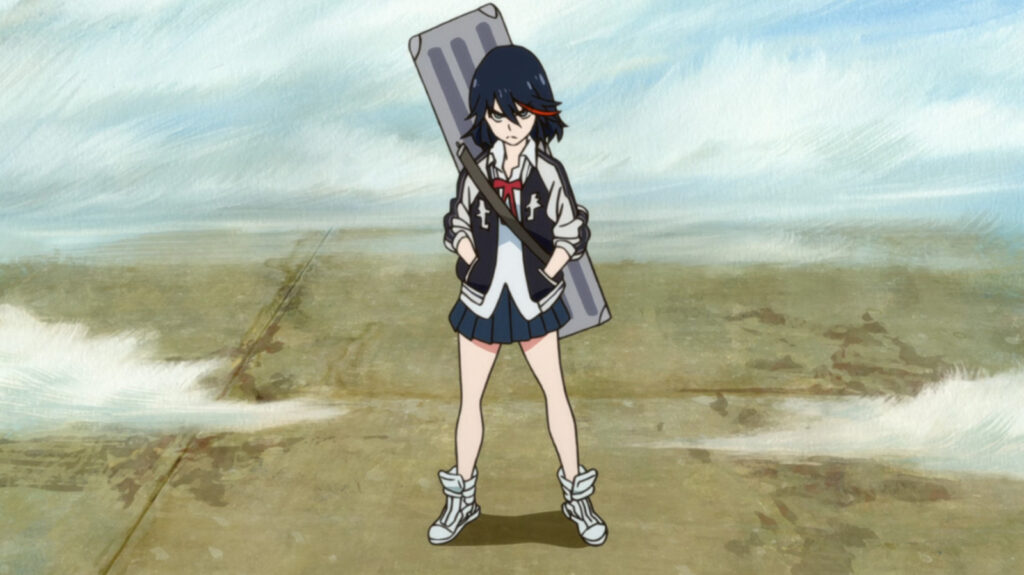
An essential part of a superhero’s identity is their costume. The color scheme and silhouette of a hero’s clothes tell you a lot about them. Batman’s black costume fades into the shadows as a dark knight’s should, whereas Superman’s bright blue and red one speaks to “Truth, Justice, and the American Way.”
Who’s the comic (anti)hero with the tightest bond to their costume? Venom, of course, for his suit (a dark mirror of Spider-Man) is a living being. The “Venom” movie trilogy leaned in on this, becoming a buddy-romantic comedy between Eddie Brock and the eponymous symbiote alien (both played by Tom Hardy). Yet Venom isn’t the only one out there with a living, alien costume. The concept also rears its head in Studio Trigger’s 2013 action-comedy anime “Kill la Kill.”
Trigger is one of the biggest production houses in modern anime; their recent adaptation of Ryoko Kui’s manga “Delicious in Dungeon” topped /Film’s list of 2024’s best anime. Founded in 2011 by Hiroyuki Imaishi and Masahiko Ōtsuka, Trigger’s oeuvre tends to be colorful action shows filled with physics-defying action, fast-paced tonal and animation shifts, and sharp plot twists.
The original model for Trigger is the 2007 anime “Gurren Lagann,” directed by Imaishi and produced at his and Ōtsuka’s previous employer, Studio Gainax. “Gurren Lagann” is the spiritual beginning of Studio Trigger (the same way Hayao Miyazaki’s “Nausicaä Of The Valley Of The Wind” set the stage for Studio Ghibli to rise), but “Kill la Kill” was the first anime series produced at the studio.
“Kill la Kill” was also directed by Imaishi (and written by “Gurren Lagann” head writer Kazuki Nakashima). It follows Ryuko Matoi, a punkish 17-year-old out to discover the truth of her father’s unsolved murder. Her main partner in this quest is her schoolgirl uniform: the living, talking “kamui” she names Senketsu.
“Gurren Lagann” was a proudly masculine show, one that showed how true men lift others up instead of grinding them down. “Kill la Kill” is about femininity and how what we wear reinforces how we feel and act.
Kill la Kill tests if fanservice can also be empowerment
“Kill la Kill” is science fiction. Incredibly soft science fiction, but the villains are aliens and the fantastic powers in the show derive from technology. So in the strictest sense, Ryuko is not a “magical girl.” She’s also much less delicate than such a character usually is, with a stubborn and trash-talking attitude.
Watching her in action, though, you can’t help but think of the “magical girl” genre. Whenever she goes into battle, Senketsu transforms around her in a power-up sequence right out of Japanese action-girl classics like “Cutie Honey” and “Sailor Moon.” Ryuko’s transformation makes her more powerful, but also more exposed; her skirt shrinks and Senketsu goes from revealing just her midriff to nearly her whole torso. Ryuko is embarrassed, at first, but her friend Mako encourages her to wear her barely-there superpowered outfit with pride.
I’m torn on whether I’d call “Kill la Kill” a feminist series, but it is a body positive one — and those two seemingly overlapping themes in fact contain the heart of the contradiction. The series’ framing is confined by the male gaze in the original sense of the term (defined by Laura Mulvey): Ryuko’s transformation is framed primarily in close-ups of her body, and the sound design underscores cloth smacking flesh. This and the lacy suspenders and stockings of Ryuko’s costume evoke bondage — and yet, the series’ titillation overlaps with the girls’ narrative empowerment. They become more powerful the less they wear because, in “Kill la Kill,” clothing is the root of subjugation.
The series’ title gives these themes away. “Kill la Kill” sounds like nonsense in English, but that’s because it contains a pun that doesn’t translate. Transliterated, the title is “Kiru ra Kiru,” and that word can mean both “to dress” and “to kill” in Japanese. There’s another pun that unlocks the meaning of the show: in Japanese, “fashhon” (“fashion”) and “fassho” (“fascism”) are pronounced nearly the same.
In Kill La Kill, fashion is a tool of fascism
The primary setting of “Kill la Kill” is Honnouji Academy, a school ruled by student council president (and seemingly Ryuko’s main rival) Satsuki Kiryuin. Imagine if a high school’s queen bee and her posse of mean girls were literally dictators. Satsuki often stands framed from a low shot, backlit and holding a sword, declaring “Fear is freedom! Subjugation is liberation! Contradiction is truth!” and such. She runs the academy with a strict class system, bestowing every student with “Goku Uniforms,” made from the same alien “life fibers” as Senketsu. The students lowest on the school’s hierarchy receive weak “no-star” Goku Uniforms, while Satsuki’s elite four wield powerful three star ones.
As in the real world, these uniforms are a self-reinforcing tool of hierarchy and division. The first “Kill la Kill” opening sequence shows row after row of miserable looking Honnouji students, all in identical uniforms, except for Ryuko. She refuses to be confined by her role at the academy, and is only aiming for the top so she can tear Satsuki down from it.
Ryuko’s main weapon in doing so is a scissor blade, usually the tool of a tailor, not a fighter. Since her opponents get their powers from their uniforms, though, she literally cuts those clothes up. Of course, a perfectly-working scissor requires two sister blades working together; along her journey, Ryuko and Satsuki learn they may be that pair for each other. Seeing them grow together across “Kill la Kill” is a fast-paced, bumpy ride you should definitely take.
“Kill la Kill” is streaming on Crunchyroll.


